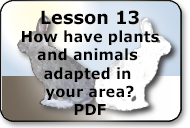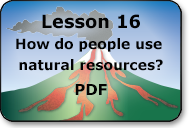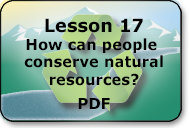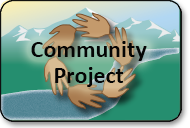How have plants and animals adapted in your area?
|
In this lesson students will find the surface area of the footprints of a snowshoe hare and the surface area of their own feet. Next they will calculate the weight load per cm2 for both the snowshoe hare and for themselves.
Download PDF
On successful completion of this lesson, students will be able to: find the total surface area of the feet of a snowshoe hare and their own feet; find the amount of weight a snowshoe hare and a student applies per cm2; and describe how weight and surface area relates to travel on snow. |
 |
|
|
| Download PDF |
|
|
|
|
|
What adaptations might your community need to make in the face of a changing climate?
|
This lesson gives students a look at rural water resources and asks them to respond to a real-life case study.
Download PDF
On successful completion of this lesson, students will be able to: interpret data from a graph;
identify the source of drinking/municipal water in their community; and describe potential affects of climate change on safe water for their community. |
|
|
|
| Download PDF |
|
|
|
|
|
|
What are natural resources?
|
In this lesson students identify renewable and nonrenewable natural resources.
Download PDF
On successful completion of this lesson, students will be able to: identify the resources used in a pencil; and identify renewable and nonrenewable natural resources; find examples of renewable and nonrenewable resources around their classroom. |
|
|
|
| Download PDF |
|
|
|
|
|
|
How do people use natural resources?
|
In this lesson, students will determine how the sea surface temperature has changed near Port Clarence and how this change affects salmon migration on the Pilgrim River.
Download PDF
On successful completion of this lesson, students will be able to:describe the relationship sea surface temperature and how it affects the timing of the salmon run; graph the change in sea surface temperature near Port Clarence; graph the arrival of salmon at a weir on the Pilgrim River; and interpret the graphs of the affect of sea surface temperature on salmon runs on Pilgrim River. |
 |
|
|
| Download PDF |
|
|
|
|
|
How can people conserve natural resources?
|
In this lesson, students build a calorimeter, test the energy content in various edible nuts and investigate biomass as an alternative energy source for Alaska communities through three case studies.
Download PDF
On successful completion of this lesson, students will be able to:
build a simple calorimeter and test the energy content of various edible nuts;
calculate the calories, per gram, released during the combustion of various nuts and graph the results; consider the feasibility of biomass as an energy source; and
examine three case studies featuring Alaska communities using biomass energy. |
 |
|
|
| Download PDF |
|
|
|
|
|
Community Project
|
In this culminating project, students use scientific processes and inquiry, along with local
knowledge to identify and propose a solution to a local problem.
On successful completion of all units in Theme 3 (Changing Lifestyles), students will be able to answer the following question with detail and specific examples appropriate to their age group: How can my community adapt to a changing landscape? |
 |
|
|
| |
|
|
|
|
|
|